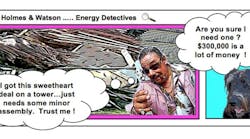Watson: Can you think of a project Holmes, where actual monitored data allowed an owner to fully utilize what they already owned and avoid a Capital Project?
Holmes: Several. One that comes to mind is a Hospital in Connecticut that was preparing to spend $300,000 to install a new 1,000 ton cooling tower.
Watson: Had they added onto the Hospital or increased the cooling load? Why did they need 1,000 more tons of cooling?
Holmes: No. They had apparently been experiencing problems for a number of years maintaining humidity control during hot, humid summer weather. I had been asked to take a look at the problem by a Design/Build Mechanical Contractor based in Boston. The contractor had determined that the problem was caused by the existing towers running out of capacity and failing to maintain the 85 degree tower return water required by the chillers.
Their solution was to recommend a new 1,000 ton tower with an installed cost of $300,000.
Watson: Did you agree that the new tower was needed?
Holmes: Not based on their recommendation alone. I wanted to see for myself so I took some portable instrumentation and spent time with the mechanical equipment at the Hospital. I reviewed the as-built drawings, compared them with the actual equipment, inspected all of the existing chillers, towers, pumps, piping and other components. I took temperature readings at all key points.
When I left after my first visit, I had the feeling that something wasn’t right, something was missing. I slept on it for a night or two and re-visited the system a couple of more times.
Watson: Oh boy! Oh boy! A mystery. Did you get out your Sherlock Holmes pipe and cap? Why didn’t you call me?
Holmes: Sorry. What I did was to sketch out the piping and compare it with a piping design book. It was a complex primary/secondary system on the condenser side of the chillers, the cooling tower side. There were multiple chillers, towers and pumps. The original designer had screwed up; the existing cooling towers had been piped wrong from the beginning.
Watson: Did the new cooling tower correct the problem? Could they cool and dehumidify the building after it was installed?
Holmes: Actually, no new tower was required. I had a welder add two short bypass pipes. It increased the flow from the existing towers, eliminated the mixing of the tower supply and return water and solved the problem. The new tower was cancelled and a planned expenditure of $300,000 was reduced to $5,000.
Watson: What did the Hospital have to say?
Holmes: After several days of record heat with no humidity problems, Ed, the Head of Facilities for the hospital called me. He asked how I could have possibly fixed his problem. And for $5,000? He said, “That system has never worked right since it was designed more than ten years ago. We have had six different engineering firms in here trying to fix it and all any of them did was have us spend more money on fixes that didn’t work. How did you do it?”
I said, “Ed, I’d like to tell you it was due to my superior intellect and engineering skills but I just looked in a piping book. It was piped wrong from the beginning. We modified the piping and the problem was fixed. Apparently none of the other engineers bothered to look in a piping book.” And Ed, “by the way, you owe me $150,000 for my two days work.” Dead silence. Just kidding!
Watson: Obviously it wasn’t quite as simple as you told Ed. Otherwise the previous engineers would have solved it. How much new equipment do people buy when all they need to do is tune-up what they already own to bring it back to full capacity?
Holmes: I couldn’t begin to estimate a percentage, but I can say that it’s got to be a lot. It’s much easier and more profitable, particularly for people with limited budgets, time or engineering skills to recommend new equipment than to analyze and solve a problem with existing systems. That’s where actual monitored data coupled with experienced, competent engineers is essential.
Watson: Had this Hospital had a permanent monitoring system with comprehensive analytics from the beginning they most likely could have avoided the expense, discomfort, liability concerns and frustration associated with the failures of six different engineering firms. They would have been able to immediately see that the fixes didn’t fix their problem.
Holmes: Watson, you’re a genius!
Tell us about your experiences, both good and bad with energy professionals, what has worked and what hasn’t. Send us your comments, thoughts and suggestions on how to improve our profession so we can all continue to learn from each other. Thanks – Holmes & Watson.
